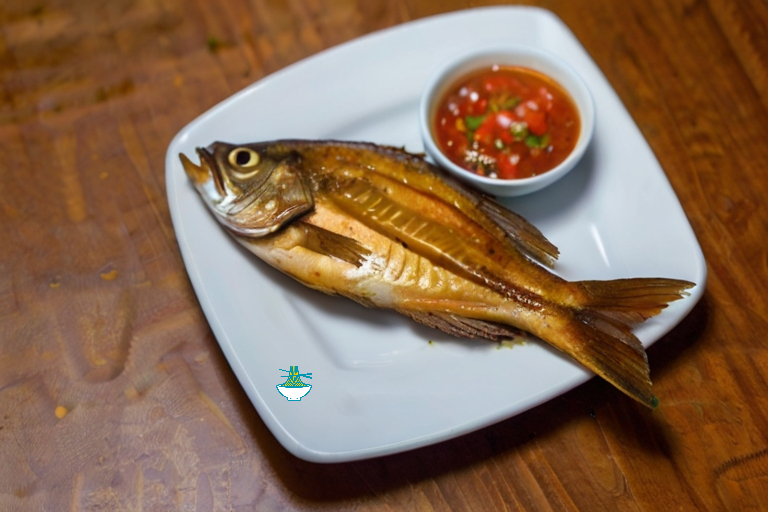Indulge in the flavors of El Salvador with the tantalizing dish of Pescado Frito. This traditional delicacy showcases the essence of Salvadoran cuisine, featuring succulent fish fillets fried to crispy perfection. Seasoned with a blend of aromatic spices and accompanied by a medley of fresh ingredients, including lime, cilantro, and ripe avocado, each bite offers a symphony of flavors that will transport you to the vibrant streets of El Salvador. Whether enjoyed as a street food snack or a hearty meal, Pescado Frito captures the essence of coastal dining with its crispy texture and delightful taste. Immerse yourself in the culinary heritage of El Salvador with this irresistible dish that promises to satisfy your cravings and leave you longing for more.

Ingredients:
- 4 fresh fish fillets (such as tilapia or red snapper)
- 1 cup all-purpose flour
- 1 teaspoon salt
- 1 teaspoon black pepper
- 1 teaspoon garlic powder
- Vegetable oil for frying
- Lime wedges, for serving
- Fresh cilantro leaves, for garnish
- Avocado slices, for garnish
For the salad:
- Mixed greens (lettuce, spinach, arugula)
- Tomatoes, sliced
- Red onion, thinly sliced
- Cucumber, sliced
- Lime juice
- Salt and pepper to taste
For the rice:
- 1 cup long-grain white rice
- 2 cups water
- Salt to taste

Instructions:
1- Rinse the fish fillets under cold water and pat them dry with paper towels.
2- In a shallow dish, mix together the flour, salt, pepper, and garlic powder.
3- Heat vegetable oil in a large frying pan over medium-high heat.
4- Dredge each fish fillet in the seasoned flour mixture, shaking off any excess.
5- Carefully place the coated fillets into the hot oil and fry until golden brown and crispy, about 3-4 minutes per side depending on thickness. Make sure not to overcrowd the pan; fry in batches if necessary.
6- Once cooked, transfer the fried fish to a plate lined with paper towels to drain any excess oil.
7- While the fish is frying, prepare the salad by tossing together the mixed greens, sliced tomatoes, red onion, and cucumber in a bowl. Dress with lime juice, salt, and pepper to taste.
8- For the rice, rinse the rice under cold water until the water runs clear. In a medium saucepan, bring 2 cups of water to a boil. Stir in the rice and salt, reduce the heat to low, cover, and simmer for about 18-20 minutes, or until the rice is tender and the water is absorbed. Fluff the rice with a fork before serving.
9- Serve the crispy Pescado Frito hot with lime wedges, fresh cilantro leaves, avocado slices, rice, and salad on the side.
Enjoy your flavorful and satisfying El Salvador Pescado Frito meal!
Nutritional Values :
Fish Fillets (Tilapia, Red Snapper, etc.):
- Serving size: 1 fillet (approximately 100-150g)
- Calories: 100-150 kcal
- Protein: 20-25g
- Fat: 1-5g (depending on type of fish)
- Carbohydrates: 0g
benefits
- Rich source of high-quality protein.
- Provides essential omega-3 fatty acids for heart and brain health.
All-Purpose Flour:
- Serving size: 1 cup (approximately 120g)
- Calories: 455 kcal
- Protein: 12g
- Fat: 1.2g
- Carbohydrates: 95g
benefits
- Supplies carbohydrates for energy.
- Contains some protein and essential nutrients like iron and B vitamins.
Vegetable Oil (for frying):
- Serving size: 1 tablespoon (approximately 14g)
- Calories: 120 kcal
- Fat: 14g
- No significant protein or carbohydrates
benefits
- Provides healthy fats that are necessary for absorption of fat-soluble vitamins.
- Helps maintain cell structure and function.
Lime:
- Serving size: 1 lime (approximately 67g)
- Calories: 20 kcal
- Vitamin C: 19mg (21% DV)
- Carbohydrates: 7g
- Fiber: 2g
benefits
- Excellent source of vitamin C, which boosts the immune system and promotes skin health.
- Contains antioxidants that protect against cell damage.
Avocado:
- Serving size: 1 avocado (approximately 200g)
- Calories: 320 kcal
- Fat: 29g
- Protein: 4g
- Carbohydrates: 17g
- Fiber: 13.5g
benefits
- Rich in monounsaturated fats, which are heart-healthy.
- Provides fiber for digestive health and promotes satiety.
Fresh Cilantro:
- Serving size: 1/4 cup (approximately 4g)
- Calories: 1 kcal
- No significant macronutrients
benefits
- Contains antioxidants and vitamins A and K.
- Has antibacterial properties and may aid digestion.
- Rice (Long-Grain White Rice):
- Serving size: 1 cup cooked (approximately 158g)
- Calories: 205 kcal
- Protein: 4.25g
- Fat: 0.44g
- Carbohydrates: 44.5g
- Fiber: 0.6g
benefits
- Good source of carbohydrates for energy.
- Contains some protein and essential nutrients like manganese and magnesium.
Mixed Greens (Lettuce, Spinach, Arugula, etc.):
- Serving size: 1 cup (approximately 30g)
- Calories: 5-10 kcal (depending on the type of greens)
- Protein: 0.5-1g
- Carbohydrates: 1-2g
- Fiber: 0.5-1g
benefits
- Low in calories and rich in vitamins, minerals, and antioxidants.
- Provides fiber for digestive health and promotes overall well-being.
These values are approximate and can vary based on factors such as portion size, specific ingredients used, and preparation methods.


Comments